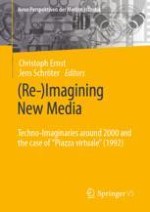2021 | Buch
(Re-)Imagining New Media
Techno-Imaginaries around 2000 and the case of "Piazza virtuale" (1992)
herausgegeben von: Dr. Christoph Ernst, Prof. Dr. Jens Schröter
Verlag: Springer Fachmedien Wiesbaden
Buchreihe : Neue Perspektiven der Medienästhetik
